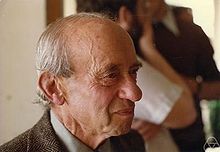Alfred Tarski
Tarski taught and carried out research in mathematics at the University of California, Berkeley, from 1942 until his death in 1983.
[9] Henceforth Tarski attended courses taught by Łukasiewicz, Sierpiński, Stefan Mazurkiewicz and Tadeusz Kotarbiński, and in 1924 became the only person ever to complete a doctorate under Leśniewski's supervision.
[12] Before World War II, it was not uncommon for European intellectuals of research caliber to teach high school.
Hence until his departure for the United States in 1939, Tarski not only wrote several textbooks and many papers, a number of them ground-breaking, but also did so while supporting himself primarily by teaching high-school mathematics.
They had two children; a son Jan Tarski, who became a physicist, and a daughter Ina, who married the mathematician Andrzej Ehrenfeucht.
[14] Tarski applied for a chair of philosophy at Lwów University, but on Bertrand Russell's recommendation it was awarded to Leon Chwistek.
[15] In 1930, Tarski visited the University of Vienna, lectured to Karl Menger's colloquium, and met Kurt Gödel.
Once in the United States, Tarski held a number of temporary teaching and research positions: Harvard University (1939), City College of New York (1940), and thanks to a Guggenheim Fellowship, the Institute for Advanced Study in Princeton (1942), where he again met Gödel.
In 1942, Tarski joined the Mathematics Department at the University of California, Berkeley, where he spent the rest of his career.
His students, many of whom became distinguished mathematicians, noted the awesome energy with which he would coax and cajole their best work out of them, always demanding the highest standards of clarity and precision.
[20]A charismatic leader and teacher, known for his brilliantly precise yet suspenseful expository style, Tarski had intimidatingly high standards for students, but at the same time he could be very encouraging, and particularly so to women — in contrast to the general trend.
[21]Tarski supervised twenty-four Ph.D. dissertations including (in chronological order) those of Andrzej Mostowski, Bjarni Jónsson, Julia Robinson, Robert Vaught, Solomon Feferman, Richard Montague, James Donald Monk, Haim Gaifman, Donald Pigozzi, and Roger Maddux, as well as Chen Chung Chang and Jerome Keisler, authors of Model Theory (1973),[22] a classic text in the field.
Tarski presided over the Association for Symbolic Logic, 1944–46, and the International Union for the History and Philosophy of Science, 1956–57.
This is a very curious result, because Alonzo Church proved in 1936 that Peano arithmetic (the theory of natural numbers) is not decidable.
[31] Using some ideas of Mario Pieri, in 1926 Tarski devised an original axiomatization for plane Euclidean geometry, one considerably more concise than Hilbert's.
In 1929 he showed that much of Euclidean solid geometry could be recast as a second-order theory whose individuals are spheres (a primitive notion), a single primitive binary relation "is contained in", and two axioms that, among other things, imply that containment partially orders the spheres.
Relaxing the requirement that all individuals be spheres yields a formalization of mereology far easier to exposit than Lesniewski's variant.
[7][35][36] However, Tarski often expressed great admiration for Charles Sanders Peirce, particularly for his pioneering work in the logic of relations.
His semantic methods, which culminated in the model theory he and a number of his Berkeley students developed in the 1950s and 60s, radically transformed Hilbert's proof-theoretic metamathematics.
[38] In 1937, he published a paper presenting clearly his views on the nature and purpose of the deductive method, and the role of logic in scientific studies.
[29] His high school and undergraduate teaching on logic and axiomatics culminated in a classic short text, published first in Polish, then in German translation, and finally in a 1941 English translation as Introduction to Logic and to the Methodology of Deductive Sciences.
In 1933, Tarski published a very long paper in Polish, titled "Pojęcie prawdy w językach nauk dedukcyjnych",[40] "Setting out a mathematical definition of truth for formal languages."
The debate centers on how to read Tarski's condition of material adequacy for a true definition.
In 1936, Tarski published Polish and German versions of a lecture, “On the Concept of Following Logically",[41] he had given the preceding year at the International Congress of Scientific Philosophy in Paris.
(Tarski 1986) is the published version of a talk that he gave originally in 1966 in London and later in 1973 in Buffalo; it was edited without his direct involvement by John Corcoran.
Mautner (in 1946), and possibly[clarification needed] an article by the Portuguese mathematician José Sebastião e Silva, anticipated Tarski in applying the Erlangen Program to logic.
So, "rotate 30 degrees" and "magnify by a factor of 2" are intuitive descriptions of simple uniform one-one transformations.)
If one identifies the truth value True with the domain set and the truth-value False with the empty set, then the following operations are counted as logical under the proposal: In some ways the present proposal is the obverse of that of Lindenbaum and Tarski (1936), who proved that all the logical operations of Bertrand Russell's and Whitehead's Principia Mathematica are invariant under one-to-one transformations of the domain onto itself.
[citation needed] Vann McGee (1996) provides a precise account of what operations are logical in the sense of Tarski's proposal in terms of expressibility in a language that extends first-order logic by allowing arbitrarily long conjunctions and disjunctions, and quantification over arbitrarily many variables.

